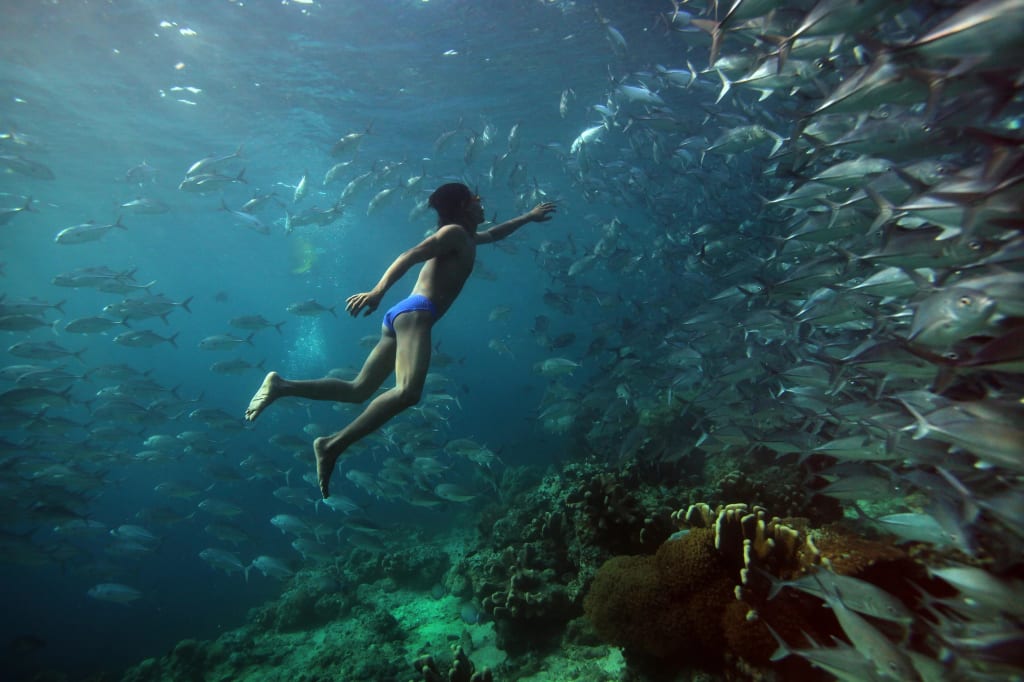‘SUPERHUMAN’ Tribe Can Hold Breath for 13 MINUTES Underwater
Aquaman In Real Life

Is it possible that humans could be like fish and survive underwater?
Surprisingly, evidence has emerged showing this aquatic fact is kind of true!
We’re a way off from being able to breathe in the water like mermaids but one tribe certainly
knows what they’re doing when it comes to spending long periods in the briny deep.
The Bajau People were first mentioned in the 16th century, via the journal of pioneering
Venetian explorer Antonio Pigafetta. They’re native to Indonesia, and also the southern Philippines and Malaysia. The tribe relies on the water for their way of life, collecting meals from the sea bed.
This means they spend an awful lot of time submerged in the wet stuff!
In fact, diving is a full-time occupation for them. The Bajau reportedly devote 8 hours a day to going underwater with only a mask and a weight to keep themselves in position.
During their dives, the Bajau people have developed a unique ability to hold their breath for extended periods and dive to great depths without the aid of any breathing apparatus. This remarkable skill is believed to be a result of their genetic adaptation to their aquatic lifestyle.
Studies have shown that the Bajau people have larger spleens compared to other populations, which enables them to store more oxygen-rich red blood cells. This adaptation allows them to have increased oxygen levels in their bloodstream, providing them with the ability to stay underwater for longer periods.
Additionally, their diving techniques and lifestyle have likely contributed to their enhanced breath-holding ability. The Bajau people start diving at a young age and gradually build up their diving skills and breath-holding capacity over time. They have also developed techniques to slow down their heart rate and conserve oxygen while underwater.
It's important to note that while the Bajau people have adapted to their aquatic lifestyle, they still need to resurface for air eventually. They cannot survive indefinitely underwater like fish.
The unique abilities of the Bajau people have fascinated scientists and have shed light on the potential for human adaptation to different environments. However, it is unlikely that humans as a whole could evolve to survive underwater without the aid of technology or significant genetic modifications.
But how come they can last below the surface for longer than the average person…?
The answer lies in human biology. You see the Bajau possess a certain something about them that makes them excellent at surviving in the water.
That certain something is an enlarged spleen!
The spleen is a versatile organ that is found in your abdomen. It’s known for recycling old red blood cells, in addition to storing white blood cells. There are lots of other things it does too, but we’re in danger of being derailed here. The point is the spleen plays an essential role in how the Bajau last in the drink. Have you heard of the human dive response?
It’s when you go through a process called “peripheral vasoconstriction”, in other
words, your heart rate is reduced and your blood vessels shrink. They do this on the outer reaches of your body to keep oxygenated blood where it’s seriously needed in your organs.
The spleen then contracts, pumping out oxygenated red blood cells and supplying you with extra oxygen.
This adaptation allows the Bajau people to have increased oxygen levels in their bloodstream, which helps them stay underwater for longer periods. The larger spleen enables them to store more oxygen-rich red blood cells, providing them with a reserve of oxygen when they are submerged.
Additionally, the Bajau people have developed techniques to slow down their heart rate and conserve oxygen while underwater. These techniques, combined with their genetic adaptation, contribute to their ability to hold their breath and dive to great depths.
It's important to note that while the Bajau people have adapted to their aquatic lifestyle, they still have physiological limits and cannot survive indefinitely underwater like fish.
With their bigger than average spleens, the Bajau can take it to the limit for their underwater
exploits. Now, a logical explanation for these spleens is that the Bajau are always diving, so their
bodies adapted accordingly, right?
That’s a nice idea but not strictly accurate.
Scientific study showed the spleens were present in those who dived but also those who didn’t.
However, there is a definite size difference in Bajau spleens and those of their neighbors.
It could, of course, be that the diving has had an effect that’s passed down through
all descendants but this is possibly a subject for another time.
So, if there are humans on the planet who are suited to undersea life, it makes you wonder
if other types of “superhumans” are out there.
Maybe who can walk around in incredibly high temperatures, or who can tolerate severe cold?
It's intriguing to consider the possibility of other types of "superhumans" who may have adapted to extreme environments. Humans have shown remarkable adaptability throughout history, and there are certainly individuals and populations who have developed unique physiological traits suited to specific environments.
For example, certain indigenous populations living in extremely cold regions, such as the Inuit people of the Arctic, have developed adaptations to withstand the cold. They have a higher metabolic rate, increased body fat, and enhanced heat production mechanisms, allowing them to thrive in freezing temperatures.
Similarly, individuals living in hot and arid regions, like the Bedouin people of the Arabian Desert, have evolved to tolerate high temperatures. They have adaptations such as lower sweat rates, increased blood volume, and efficient water conservation mechanisms.
These adaptations are the result of both genetic factors and cultural practices that have been passed down through generations. However, it's important to note that these adaptations are specific to certain populations and may not be present in all individuals.
Exploring the diversity of human adaptations to extreme environments can provide valuable insights into the potential for human evolution and our ability to survive in different conditions.
This is starting to sound like an X-Men comic, so it’s best to let science do the talking
and leave it there…
About the Creator
Enjoyed the story? Support the Creator.
Subscribe for free to receive all their stories in your feed. You could also pledge your support or give them a one-off tip, letting them know you appreciate their work.





Comments
There are no comments for this story
Be the first to respond and start the conversation.